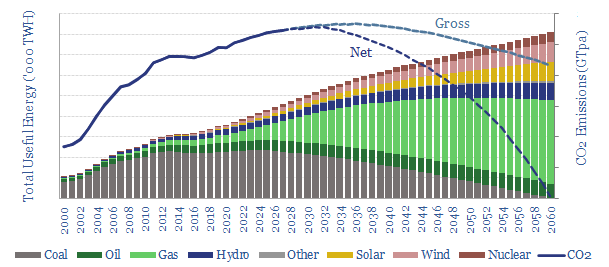China now aspires to reach ‘net zero’ CO2 by 2060. But is this compatible with growing an industrial economy and attaining Western living standards? Our 16-page note finds the best middle ground to balance these objectives: Coal is phased out, oil demand plateaus at 20Mbpd, gas rises by a vast 10x to 300bcfd, and 9GTpa of gross CO2 emissions must be captured or offset. The biggest challenges are geopolitics and sourcing enough LNG.
The vastness of China’s industrial economy is outlined on pages 2-4. China’s industrial complex consumes more energy than the entire USA. China’s textile manufacturing industry alone consumes more energy than the entire power grid of Spain. We provide data by major sector and by energy source.
It is more challenging to decarbonize an industrial economy than a service-oriented economy. These are our findings on pages 5-6.
A high case scenario is laid out on pages 7-9. It is not impossible that China’s CO2 doubles by 2060, more than offsetting all decarbonization efforts in the West. This would be problematic.
A low case scenario is laid out on pages 10-12. The easiest route to reaching net zero is if China chooses slower economic growth and less economic development for its citizens. But is this remotely fair or realistic?
A middle-ground solution is given on pages 13-15. This is our base case. Full decarbonization is achieved, without materially sacrificing growth and development. But vast changes are needed in China’s energy sector.
The largest bottleneck to achieving this bottleneck is whether China can source enough gas, especially LNG, to reduce its reliance on coal, as argued on page 16. The ramp-up in renewables is also vast, but realistic, we think.
